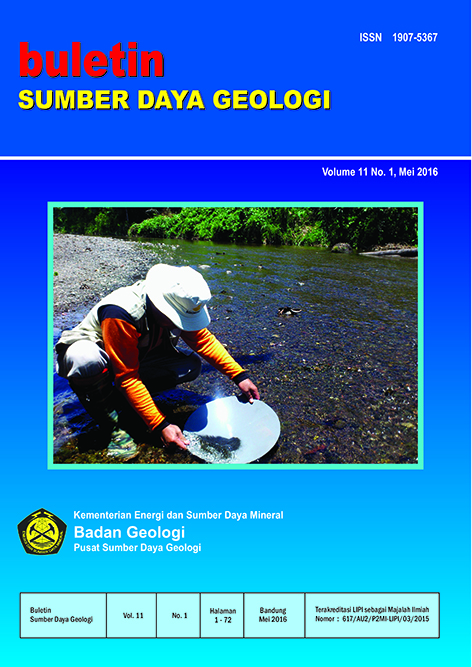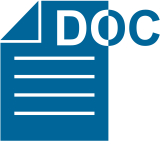RESPONSE OF STABLE OVERALL SLOPE GEOMETRY OF OPEN PIT COAL MINE IN WARUKIN FORMATION TO DEWATERING AND PEAK GROUND SEISMIC IN SOUTH KALIMANTAN, INDONESIA
Abstract
Understanding of the response of the mine slope stability is very important regarding the safety of life and investment / productivity / environment, as anticipation of landslide prevention based on the latest research. Mine slope behavior previously discussed widely in terms of the response due to dewatering and seismic (Peak Ground Acceleration) as well through verification. This paper aims to obtain a broad dimension of design criteria that are not only unstable slopes, but the slope is stable under various conditions of the rock mass saturation (dewatering) and seismic condition. Response of slope stability per geotechnical rocks unit from different formations or any engineering formation as a result of environmental influences, for example, the same quake, will be different. This means that the geometry of the same slope in other formation will have different stability conditions (safety factor of the slope) due to the same seismic acceleration. This is also similar due to dewatering. The method used for this study is the deductive-probabilistic method with a hypothetical verification approach. The Standard statistical analysis is used to test the data normality and homogeneity, average and independent differences, as well as regression-correlation test. The research results show that dewatering activitycan decrease ground water level (GWL/MAT) of the slope, so the durability of sliding along the sliding plane is reduced (increasing slope safety factor). At the same time earthquake reduces shear strength and increases driving force, so the safety factor of the slope suddenly downs. Slope stability decreased due to the earthquake, but dewatering improves slope stability. Thus, the slope in dewatering conditions will be kept stable through simulation to anticipate earthquake.
Downloads
References
Anonymous, 2013, Report on Geotechnical and Hydrological Study of Kintap Area, South Kalimantan. Unpublished report.
Asrurifak, M., Irsyam, M., Budiono, B., Triyoso, W., Hendriyawan., 2010, Development of Spectral Hazard Map for Indonesia with a Return Period of 2500 Years using Probabilistic Method, Civil Engineering Dimension, Vol. 12, No. 1, March 2010, 52-62 ISSN 1410-9530 print/ISSN 1979-570X online
Dearman, W.R., 1991, Engineering Geological Mapping, Butterworth-Heinemann
Giani, G.P., 1992, Rock Slope Stability Analysis, A.A. Balkema, Rotterdam, pp 7, 39, 45 – 46, 281 -290.
Hirnawan, F., 1993, Ketanggapan Stabilitas Lereng atas tanaman keras, hujan, dan gempa, PhD thesis in the Universitas Padjadjaran, Unpublished.
Hoek E., and Bray J., 2005, Rock Slope Engineering – Civil and Mining, 4th edition, Taylor & Francis Group.
Irsyam, M., Sengara, W., Aldiamar, F., Widiyantoro, S., Triyoso, W., Natawidjaja, D.H., Kertapati, E.K., Meilano, I., Suhardjono, Asrurifak, M., dan Ridwan, M., 2010, Ringkasan Hasil Studi Tim Revisi Peta Gempa Indonesia 2010, Kementerian Pekerjaan Umum.
Liliefors, H.W., 1967. On the Kolmogorov-Smirnov Test for Normality with mean and variance unknown, Journal of The American Statistical Association. Vol. 62, No. 318, Jun.1967, pp. 339 - 402
Steffen, O.K.H, 1997, Planning of Open Pit Mines on a Risk Basis, The Journal of The South African Institute of Mining and Metallurgy, pp.47-56.
Zhang, J., Tang, W.H. and Zhang, L.M. (2010), Efficient Probabilistic Back-Analysis of Slope Stability Model Parameters, Journal of Geotechnical and Geoenvironmental Engineering, ASCE, January, pp 99-109.
Zufialdi Zakaria, Dicky Muslim, & Irvan Sophian, 2012, Koreksi SMR Pada Desain Lereng Tambang Terbuka Batubara Pada Formasi Balikpapan & Formasi Kampungbaru, Sangasanga, Kalimantan Timur, Buletin Sumber Daya Geologi Volume 7 Nomor 3 – 2012,hal.147– 157
Copyright (c) 2017 Buletin Sumber Daya Geologi

This work is licensed under a Creative Commons Attribution-NonCommercial-ShareAlike 4.0 International License.
Authors whose manuscripts are published agree to the following terms:
The publication rights of all journal manuscript materials published on the Buletin Sumber Daya Geologi website are held by the editorial board with the knowledge of the author (moral rights remain with the manuscript’s author).
The formal legal provisions for access to digital articles in this electronic journal are subject to the terms of the Creative Commons Attribution-ShareAlike (CC BY-SA) license. This means that Buletin Sumber Daya Geologi has the right to store, convert media/formats, manage in the form of a database, maintain, and publish the article without requesting permission from the author, as long as the author’s name is cited as the copyright holder.
Manuscripts published in both print and electronic formats are open access for educational, research, investigative, and library purposes. Beyond these purposes, the editorial board is not responsible for any violations of copyright law.















